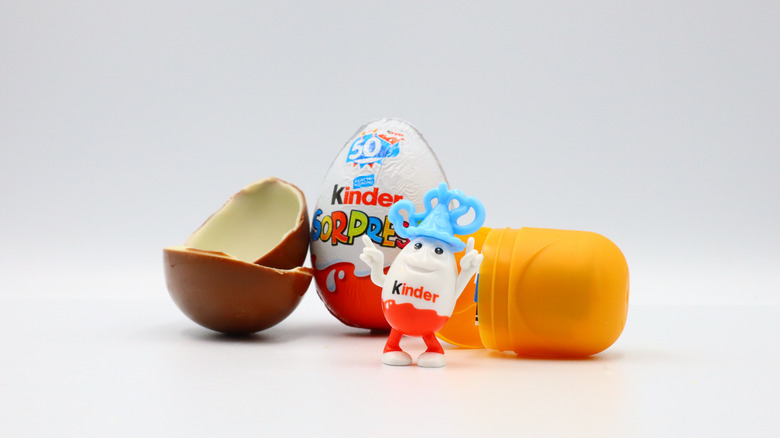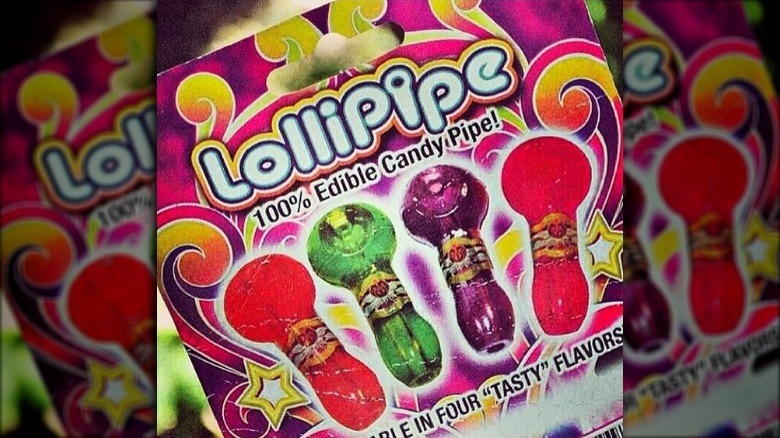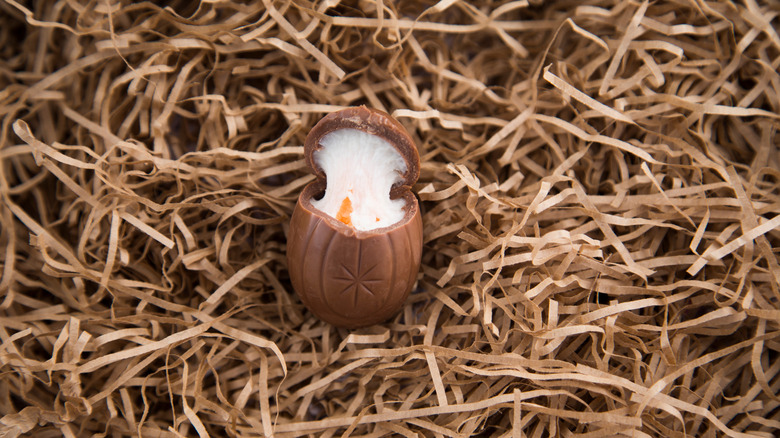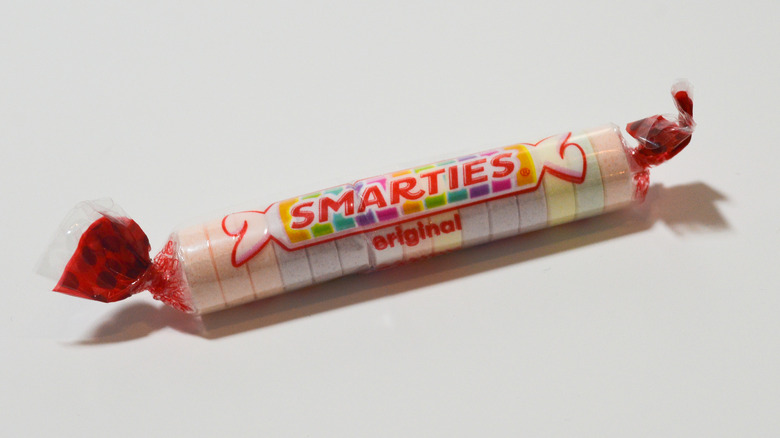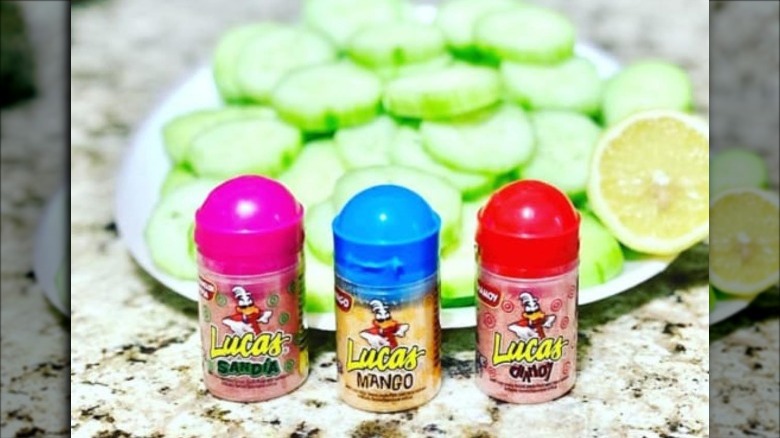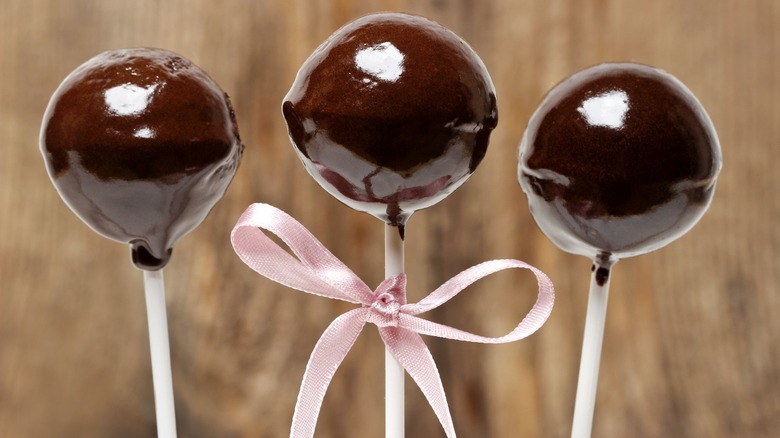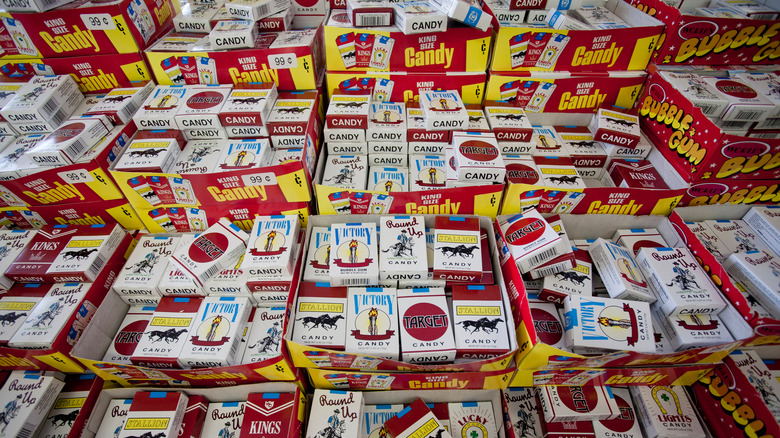Candies That Were Banned In The United States
Candy is surely one of the few universal joys in the world. There's literally no point to it, at least nutritionally speaking, except to taste good and make you feel good. And honestly? The world needs some more of those things.
There's a catch, though. Turns out that not all candy is created equal, and some candy has proven to be downright controversial enough to get slapped with a ban. Sometimes, that's a ban put in place by schools or communities, meaning you could find the candy in question somewhere else in the United States. Sometimes, however, it's a ban that covers the entire country.
There are some cases — like those in which some candy has been found to contain harmful substances — where it's easy to understand why governing bodies like the U.S. Food and Drug Administration put a stop to importing some candies into the country. There are other cases that are less clear, making it easy to see why some of these more controversial bans might have candy fans up in arms even today. So, let's talk about candies that have been banned from the United States for one reason or another. We'll leave it up to you to decide whether or not the ban in question was just.
Kinder Surprise Eggs were banned for safety reasons
Kinder Surprise eggs are available practically everywhere there are people on the globe ... except for in the United States. For those who haven't had them, they're basically chocolate eggs that hide a toy inside a hollow shell — and it's the toy that's not only made them incredibly popular, but incredibly illegal in the US.
According to Marketplace, the law that got Kinder Surprise banned in the US goes back to 1938. The legislation in question basically outlaws candy that has a "non-nutritive object" embedded in it, which precisely describes the Kinder Surprise. And it's a ban that's stuck around for decades. US Customs and Border Protection has released memos about the ban as recently as 2012.
In 2017, NPR talked to Joe Wos about that time he tried to bring a couple of boxes back from Belgium. He was stopped at the airport and told that the only way he was going to be able to keep any of it was if he ate all the chocolate right there (he did). His weren't the only ones that were confiscated: in 2015 alone, they seized somewhere around 30,000 of the chocolate eggs.
So wait, what about the Kinder Joy eggs that are on American shelves? Taste of Home says they launched stateside in May of 2018, though this modified version, oddly enough, must be eaten with a spoon.
Candy shaped like drug paraphernalia has been unsurprisingly controversial
In a case of, "Wow, no one saw that coming," it turns out that some people have a real problem with stores selling candy pipes. The product in question is called Lollipipe, and it's a candy pipe that the New Haven Register says comes with "a plastic toke tube, an airtight pouch, and a cigar band for no-stick handling." They add that the candies are reusable, and the company behind them promotes them as something that should be used for only legal substances. Still, that didn't stop quite a few people from pointing out that yes, a person could absolutely smoke some less than legal things with these candies.
When Connecticut police investigated a tip that a local gas station was selling the candy pipes, they stressed that they were only illegal if used in conjunction with illegal substances. The store owner did hand over a range of samples for use in teaching community parents about what products were easily accessible to their children.
That gas station took Lollipipes off the shelves voluntarily, but others went a step further. 7-Eleven stores in Indiana banned the Lollipipe completely, says ABC News, while KXLY reports that residents of Spokane, Washington were partnering with the Greater Spokane Substance Abuse Council to push for a similar ban on the potentially alarming candy pipes.
How Cadbury got banned
Anyone who's had both European and American chocolate can attest to the fact that these sweets are very, very different. That's part of the reason why so many people were very upset when, in 2015, Cadbury was effectively banned from US shelves.
Here's the shortened version of what happened (via The New York Times): Hershey went after Cadbury to stop them from importing British chocolates they claimed were infringing on their trademarks. Toffee Crisps, for example, were cited as looking too much like a stateside Reese's product because of their similar colors. Meanwhile, there was a slightly different problem with Yorkie bars produced by Cadbury. Hershey claimed the name was too similar to their York Peppermint Patty.
Mic reports that the whole affair was further complicated by the fact that Hershey had an agreement to make their own version of some of Cadbury's candies, like Creme Eggs, for American markets. The recipe was different, but the presence of British candies on American shores was seen as competition and confusion that Hershey just didn't want on its turf. As a result, Americans had to wave goodbye to Cadbury products from across the pond. That said, some small stores have managed to keep importing candies under the radar, which is why you can sometimes still find the real deal in spite of the ban.
It only takes a few to ruin Smarties for the many
Smarties are a polarizing, love-or-hate sort of candy for many people, but back in 2014, they were a cause for major concern. According to USA Today, a new trend was hitting schools: snorting Smarties.
It sounds bizarre, but so are many trends practiced by elementary school kids. USA Today reported that a 3rd grader had already been suspended for snorting crushed Smarties. At the time, it wasn't really clear what the point of the whole exercise was supposed to be, aside from mimicking the act of snorting cocaine. Rhode Island schools were warning their parents of risks of snorting crushed Smarties, which included infections, nasal scarring, choking (such as on a large piece of uncrushed candy), and the possibility of developing respiratory issues like asthma. And it wasn't just students doing it — a quick YouTube search had turned up hundreds of videos of even adults trying out the odd practice.
The trend of snorting Smarties led to the candy being banned in schools in many states, like Maine and Michigan, according to mlive. Meanwhile, other states also reported they were having "problems" with kids putting candy up their nose when clearly — do we really need to say this? — candy doesn't belong there
Valentine candy raises eyebrows in some schools
In 2015, ABC News asked whether or not Valentine's Day candy should be banned from schools. The answers varied, but there have been some schools that answered with a pretty clear and definite "yes".
According to The San Diego Union-Tribune, all the traditional Valentine's Day candy had been a February staple for years until a 2007 ban on "candy in any form," detailed in notices sent home to parents with students in Temecula, California schools. Other things — like fruit, pencils, and hearts made from melted crayons — were to be handed out instead. And while it was all done to fall in line with an attempt to steer kids toward a healthier lifestyle, not everyone was thrilled with the change. As one parent asked, "Are we going to take all the fun out of the holidays?" Others pointed out that the problem was a lack of activity, not the occasional treat of some Valentine's Day candies.
But Temecula schools weren't the only ones to ban chocolates and candy hearts. Fox News reported that in 2014, some Connecticut schools did the same thing. Even worse for some, school officials specified that the ban hammer had hit all Valentine's Day candies. As a result, some teachers even canceled their annual parties, while others suggested replacing candy with "pencils, stickers, temporary tattoos, homemade cards, or other crafts."
The strange saga of the Mexican candies with lead inside
According to Deseret News, the saga of the Lucas Limon and Lucas Limon Con Chili candies kicked off in 2004, with an investigation headed up by the Orange County Register. They found that these candies — produced by a Mexican subsidiary of Mars — had been tested and shown to contain high amounts of lead.
That's a huge deal, since the presence of lead in food has been linked to serious long-term effects like high blood pressure, kidney damage, and more, according to the World Health Organization. Even worse, when it's consumed by children, it can impact the development of their nervous system, kidneys, and hangs around for years in a person's skeletal system.
Lead might be deadly, but there was a loophole that meant these candies dodged the ban hammer. Since they were sold in packages that looked like salt shakers, they were technically labeled as "seasonings" and so remained on the shelves.
Mars claimed that they were old products, as they'd been pulled from the market voluntarily and production had — at some point — been halted in favor of candy like the version pictured. Still, that didn't happen before some states took matters into their own hands. Illinois, for example, issued a statewide embargo on Lucas candies, with local public health departments ordered to make sure store owners complained and removed the candy from their shelves (via Consumer Affairs).
Lollipops that came with a side of lead
This story doesn't have a happy start, to be sure. According to the Los Angeles Times, the saga of the lead lollipops all kicked off when a 2-year-old from Orange County, California, was found to have an abnormally and high and definitely unsafe level of lead in his system. The lead was traced to tamarind-flavored lollipops made by Dulmex and imported into the United States. Specifically, the lollipop wrappers had lead levels as high as 22,000 parts per million, well above what's deemed safe. Several other cases of lead poisoning followed the 2001 case, leading to a state-wide ban issued by California authorities.
Research published in Environmental Health Perspectives suggests that this is a widespread problem and, furthermore, that the FDA has been aware of lead-tainted candies making their way into the US and into the so-called "grey market" since at least the 1990s. Even if some "cleaner" candy is manufactured to FDA standards, it's entirely possible that other, "dirtier" candy — intended for sale in Mexico — still makes it across the border and onto shelves, particularly in small, family-owned and operated businesses.
What's Christmas without candy canes?
In a saga that proves truth is sometimes stranger than fiction, Fox News reported that, in 2018, a school principal in Nebraska banned candy canes. Why? As Principal Jennifer Sinclair claimed in a memo, "Historically, the shape is a 'J' for Jesus. The red is for the blood of Christ, and the white is a symbol of his resurrection."
That's actually been repeatedly disproven, and her attempts to also ban images of Santa Claus, reindeer, and decorations that were red and green were met with immediate pushback from the school district. Then there was the outcry from parents taking the position of what could basically be summed up as, "Seriously? What the heck?"
The ban was short-lived, as the principal was first put on leave while an investigation took place, and later, it was reported (via the New York Post) that she was not going to be returning to her position at the school. Just how, exactly, you think this situation was blown out of proportion may depend on your own personal values, but we can surely agree that it was a giant mess either way.
A favorite candy of a bygone era isn't wanted back
Few things are as surely polarizing as smoking. And to our 21st-century sensibilities, having gone through countless anti-tobacco and drug resistance programming, candy cigarettes are just weird. But we're not the first ones to think so. Candy cigarettes were first introduced in the 1930s, and as if candy that encouraged smoking wasn't weird enough, their ingredient list was even stranger. According to Northeast News, they were made from sugar, corn starch, beef gelatin, tapioca, and flavoring that made them taste like toothpaste. Yum?
The first ban actually came pretty early. In 1953, North Dakota banned the sale of candy cigarettes for fear it would lead to kids smoking the real thing, but that ban was lifted in 1967. Strange? Absolutely. So what happened?
By 1970, most companies weren't calling them "cigarettes" anymore, but calling them "sticks" didn't make these candies any less controversial. A St. Paul, Minnesota candy store found that out the hard way in 2012, when ABC reported that they had fallen afoul of the law. A city ordinance had already banned the sale of these candy sticks and the store soon found themselves facing serious fines.
While attempts at nationwide bans have failed, there are numerous local and state bans in place. The candy sticks are illegal in Tennessee and Maine, for one. Interestingly, they're also a no-go in numerous other countries, like Australia, Canada, Thailand, Saudi Arabia, Finland, Ireland, Norway, and Turkey (via Candy Favorites).

